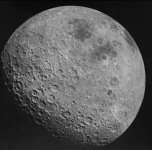It's not "locked into orbit". Drifting away.
Why the Moon is getting further away from Earth - BBC News
I never said locked in orbit.
I stated locked in one sided synchronous orbit.
That means that only one half of the Moon, the same half, is visible from Earth.
Meaning its rotation is tidally locked so that the same half always faces the Earth, while the Moon orbits it.
Ok, perhaps I misunderstood.
I think that's just what happened, not so much iron in the moon's core, so what iron it had was pulled closer to one side(?). The moon "centers" towards the earth like a magnetic compass needle.
Only assumption on my part.
shouldn't they have grabbed harder on the heaviest elements present, while the Moon's core was (or may still be) molten?.
I think that's just what happened, not so much iron in the moon's core, so what iron it had was pulled closer to one side(?). The moon "centers" towards the earth like a magnetic compass needle.
Only assumption on my part.
I've now done my research on this topic and will pass my findings on here. Hope it is helpful. 🙂If tidal forces put the brakes on its rotation, shouldn't they have grabbed harder on the heaviest elements present, while the Moon's core was (or may still be) molten?
Early in the molten Moon's history the heavier iron sank, forming a small core.
The molten Moon's local gravitational field was much stronger than the Earth's was at the distance of the Moon's orbit. The Earth's gravity is diluted with distance in accordance with the inverse square law of gravitational attraction.
The distance of the Moon from the Earth is about 60 Earth radii, so the pull of gravity of the Earth at the Moon is only 1/3600 of what it is on the Earth's surface - insignificant compared to the pull of the Moon's own gravity which is about 1/6th of that of the Earth's.
So the heavy iron was confined to the core of the early molten Moon because the Earth's gravity was not strong enough to draw the iron away from the core.
With regard to tidal forces, they are a secondary effect of the force of gravity caused by the fact that the far side of the Moon is slightly further away from the Earth than the near side. This results in the Moon having a permanent tidal bulge. The Moon is not rotationally stationary, but turns very slowly - just enough to keep the same side always face towards the Earth. Tidal forces cause the Moon to bulge at two points - the side facing the Earth and the side facing away from the Earth both bulge outwards by about 50cm.
I just watched an animated sim. Why do they say it spins on it's axis when in the sim it's clearly stationary...it orbits but does not turn on it's axis?
More questions! The Moon makes one full rotation (360 degrees) during each orbit around the Earth.
Research it for yourself here: Does the Moon Rotate? | Space"The Moon orbits the Earth once every 27.322 days. It also takes approximately 27 days for the Moon to rotate once on its axis. As a result, the Moon does not seem to be spinning but appears to observers from Earth to be keeping almost perfectly still. Scientists call this synchronous rotation."
I did. I don't get it. The declaration is "The Moon does not rotate, but it does spin on it's axis". However in the animated sim, it's always facing the same way. How is this "spinning"?
Attachments
Last edited:
The Moon does not appear to rotate as seen by an observer on Earth, but it is spinning (slowly) on it's axis.
So let's see this animated sim which may not be sufficiently animated!
So let's see this animated sim which may not be sufficiently animated!
So let's see this animated sim which may not be sufficiently animated!
I'm sorry, I can't see it because I refuse to discourage adblocker ....🙁
In the Wiki animation it doesn't seem to turn on its axis, if it does it is very slowly, surely
Rotation and translation of the Moon
The Moon revolves around the Earth approximately once a month. If the Earth did not turn on a full day, it would be very easy to detect the movement of the Moon in its orbit. This movement causes the Moon to advance around 12 degrees in the sky every day.
If the Earth did not rotate, what we would see would be the Moon crossing the celestial vault for two weeks, and then it would go away and take two weeks away, during which the Moon would be visible on the opposite side of the Globe.
However, the Earth completes a turn every day, while the Moon moves in its orbit also to the east. Thus, every day it takes the Earth about 50 more minutes to face the Moon again (which means that we can see the Moon in the Sky.) The Earth's spin and the Moon's orbital movement is they combine, in such a way that the moon's output is delayed on the order of 50 minutes every day.
Los movimientos de la Luna
The Moon revolves around the Earth approximately once a month. If the Earth did not turn on a full day, it would be very easy to detect the movement of the Moon in its orbit. This movement causes the Moon to advance around 12 degrees in the sky every day.
If the Earth did not rotate, what we would see would be the Moon crossing the celestial vault for two weeks, and then it would go away and take two weeks away, during which the Moon would be visible on the opposite side of the Globe.
However, the Earth completes a turn every day, while the Moon moves in its orbit also to the east. Thus, every day it takes the Earth about 50 more minutes to face the Moon again (which means that we can see the Moon in the Sky.) The Earth's spin and the Moon's orbital movement is they combine, in such a way that the moon's output is delayed on the order of 50 minutes every day.
Los movimientos de la Luna
I don't need an animation to convince me of such an obvious fact that the Moon turns once during each orbit around the Earth. How else would it keep one face always pointing towards us? Jings, crivvens and help mah boab as we say in Scotland!
Okay, but it's not "spinning" on it's "axis" is it?I don't need an animation to convince me of such an obvious fact that the Moon turns once during each orbit around the Earth. How else would it keep one face always pointing towards us? Jings, crivvens and help mah boab as we say in Scotland!
Certainly it is. It has to in order to keep one surface facing the earth all the time. If it were not rotating on it's axis, and it were circling around the earth, it would appear to rotate once per cycle around the earth.
- Status
- Not open for further replies.
- Home
- Member Areas
- The Lounge
- What is the Universe expanding into..




